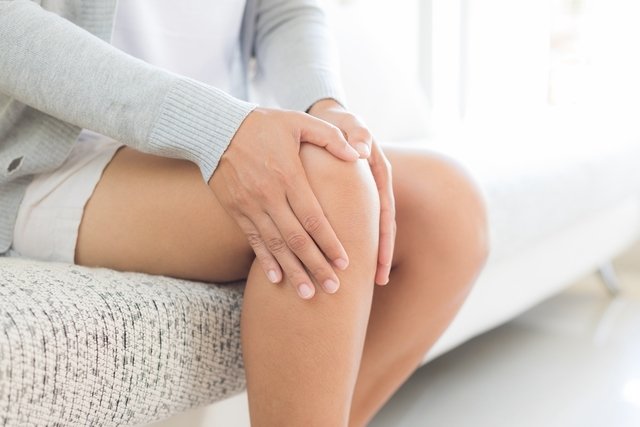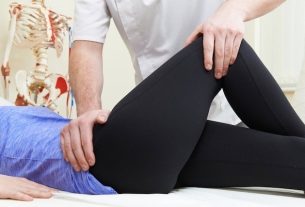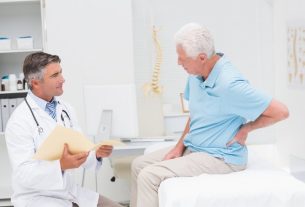Knee pain when bending can be caused by patellar tendinitis, osteoarthritis, Baker’s cyst or trauma such as falls or blows, which can result in injuries to the knee joint or ligaments, for example.
Depending on its cause, pain when bending the knee can be quite intense and interfere with daily activities, in addition to being able to have different locations, and may occur behind the knee, above or below the patella.
It is important to consult an orthopedist whenever knee pain occurs when bending, so that the cause can be identified and the most appropriate treatment can be initiated.

Main causes
The main causes of knee pain when bending are:
1. Trauma injury
Knee trauma injuries can occur as a result of a fall, bruise, blow, sprained knee, dislocation or fracture, for example.
In these cases, the pain when bending the knee appears suddenly, is intense and appears behind the knee, above or below the patella or in other regions depending on the location of the injury, and is accompanied by swelling and difficulty moving the knee. .
What to do: In the case of mild injuries, without fractures, you can rest and use an ice pack 2 to 3 times a day for 15 minutes. In cases of fracture or dislocation, you should go to the emergency room immediately to begin the most appropriate treatment. Physiotherapy may also be recommended to aid recovery and alleviate pain, even in mild cases.
2. Ligament tear
The tear of a knee ligament, such as the medial or lateral ligament, or the anterior or posterior cruciate ligament, can cause pain when bending the knee or fully straightening the leg, swelling or decreased range of motion.
Furthermore, normally before symptoms appear, it is common to hear or feel a sudden pop in the knee or to have the feeling that the knee is locked.
Knee ligament rupture is more common to occur due to sudden great effort during sports, such as football, basketball or tennis, for example.
What to do: The treatment of a torn knee ligament must be carried out by an orthopedist, and is usually done with surgery, followed by a few months of physiotherapy and rest, but initially it may be necessary to use a knee brace to prevent knee movements.
3. Patellar tendonitis
Patellar tendinitis is inflammation that occurs in the tendon that connects the patella to the shin bone, causing pain when bending the knee, pain when sitting for a long time, squatting or climbing stairs, swelling or a feeling of stiff knee when waking up.
Generally, patellar tendonitis, also called “jumper’s knee”, is caused by injuries in people who practice intense physical activity, such as running, football or cycling, or who are athletes.
What to do: you should rest the joint, avoiding repetitive efforts, and place an ice pack on the knee for 20 minutes, twice a day. Additionally, the orthopedist may recommend physical therapy, the use of anti-inflammatory medications or even surgery. Understand how tendonitis is treated.
4. Knee bursitis
Knee bursitis is the inflammation of one of the 11 bursae in the knee, which are small sacs that contain fluid and function as a shock absorber, in addition to reducing friction between the bones, tendons and muscles of the joints.
When a knee bursa is inflamed, it can cause pain when bending the knee, swelling, a feeling of heat in the area and pain above or below the knee.
Generally, knee bursitis is caused by activities such as repeatedly bending the knee or kneeling, sports such as jiu-jitsu, football and volleyball, falls or blows.
What to do: you should rest and apply an ice pack for 15 minutes, 2 to 3 times a day. Furthermore, the orthopedist may recommend physiotherapy, use of anti-inflammatories, injecting corticosteroids directly into the bursa or even surgery.
5. Meniscus injury
Pain when bending the knee, pain on the inside of the knee, pain when climbing stairs, pain when squatting or pain inside the knee, for example, may be indicative of an injury to the meniscus, which is a disc that works as a cushion or shock absorber inside. of the knee.
Generally, meniscus injuries are caused by physical activities such as judo, jiu-jitsu or by degeneration of the meniscus that occurs due to the natural aging of the body.
What to do: rest and avoid activities that move the knee a lot, as well as physiotherapy to strengthen the knee muscles. In some cases, the orthopedist may also perform corticosteroid or hyaluronic acid injections in the knee, or even surgery.
6. Quadriceps tendonitis
Pain when bending the knee can also arise due to quadriceps tendonitis, which is an inflammation of the quadriceps tendon that is located at the end of the quadriceps muscle, in the front part of the thigh, and is inserted into the knee.
When this tendon is inflamed, it can cause pain at the top of the knee when bending, stiffness in the knee, swelling or a sensation of heat in the area, which is more common to occur due to trauma to the knee caused by sports, such as running or football, for example.
What to do: The treatment of quadriceps tendonitis must be guided by an orthopedist and involves rest, avoiding exertion, use of ice packs or anti-inflammatories, physiotherapy, and in the most serious cases, surgery.
7. Tendinite isquiotibial
Hamstring tendonitis affects the tendon located in the back of the thigh, causing pain behind the knee when bending, pain on the side of the knee, swelling or pain when moving the knee.
Generally, hamstring tendinitis is caused by injuries in people who practice intense physical activity, such as running, football or cycling, or who are athletes.
What to do: the joint must rest, avoid repetitive efforts and apply an ice pack to the knee for 20 minutes, twice a day. Furthermore, the orthopedist may recommend treatment with physiotherapy, use of anti-inflammatories or surgery. See more details about tendinitis treatment.
8. Osteoarthritis in the knee
Knee osteoarthritis, also known as osteoarthritis, is the degeneration of the knee cartilage, reducing the quality, quantity and thickness of this cartilage, causing chronic pain.
This degeneration can affect day-to-day activities by causing pain below the knee when bending, stiffness in the knee in the morning, or pain in the knee when walking, at the end of the day, from standing for a long time, for example.
What to do: It is important to consult an orthopedist as treatment must be carried out with analgesics such as paracetamol or anti-inflammatories such as ibuprofen or diclofenac. In addition, physiotherapy sessions are also recommended and, in some cases, the doctor may perform corticosteroid or hyaluronic acid injections in the affected knee.
9. Iliotibial band syndrome
Iliotibial band syndrome causes burning pain on the outer side of the knee that can radiate to the thigh or hip, or pain when bending the knee, and is common in runners, cyclists or other sports that require repeated bending of the knee.
Generally, this syndrome is related to weakness and poor muscle flexibility or training errors with inappropriate intensities and volumes, in addition to the type of terrain, shoes or posture, for example, when playing sports.
What to do: you should stop practicing sports and invest in muscle strengthening activities such as weight training or stretching, always with the guidance of a physical education professional. Additionally, the orthopedist may recommend the use of anti-inflammatories in the form of ointments or tablets, and physiotherapy. See how iliotibial band syndrome should be treated.
10. Rheumatoid arthritis
Rheumatoid arthritis is an autoimmune, inflammatory and chronic disease that causes stiffness, pain and swelling in the joints, which can affect the knee and cause knee pain when bending, knee pain when waking up, being more intense during the first few minutes of the morning and improving with movement.
Furthermore, knee pain that appears with swelling but without being caused by trauma may indicate rheumatoid arthritis.
What to do: you can use analgesics and anti-inflammatories recommended by the orthopedist or rheumatologist, in addition to treatment with a physiotherapist to improve knee movement. Check out all the treatment options for rheumatoid arthritis.
11. Cisto de Baker
Baker’s cyst is a type of lump that forms in the joint behind the knee, due to the accumulation of synovial fluid, causing pain behind the knee, swelling, stiffness and pain when bending the knee, which worsens with physical activity, and a ‘ painful and mobile ball that can be palpated with the hands.
This type of cyst, which is also called a popliteal cyst, is usually related to other diseases such as rheumatoid arthritis, osteoarthritis, meniscus injury or cartilage wear, for example.
What to do: You should consult an orthopedist to identify the cause of the cyst and treat the disease that caused it, or in the case of large cysts that cause a lot of pain, the doctor can aspirate fluid from the cyst or inject corticosteroids directly into the cyst. cyst. If the cyst ruptures, treatment involves surgery. Find out more about how to treat Baker’s cyst.
12. Patellofemoral syndrome
Knee pain when bending can also be caused by patellofemoral syndrome, in which inflammation of the patellofemoral joint occurs due to flat foot, knee injuries or wear and tear of the cartilage in the knee.
Patellofemoral syndrome generally causes pain in the front and inside of the knee, which worsens when going up or down stairs, as well as other symptoms such as a clicking sensation in the knee when moving or swelling.
What to do: Treatment must be guided by an orthopedist, who may recommend physiotherapy, application of hyaluronic acid inside the knee joint or even surgery.
When to go to the doctor
It is important to consult an orthopedist in the following situations:
- Pain when bending the knee that lasts more than 3 days, even with the application of ice and rest;
- Severe or chronic pain;
- Swelling, redness or deformities in the knee;
- Difficulty with daily activities, such as standing, walking or climbing stairs;
- Noise or clicking in the knee when bending or moving;
- Unable to bend the knee;
- Fever.
In these cases, the orthopedist may order an X-ray examination or an MRI to make the diagnosis, identify the cause of knee pain when bending and indicate appropriate treatment.
Make an appointment with an orthopedist in the nearest region:
Taking care of your health has never been easier!

Sign up for our newsletter and stay up to date with exclusive news
that can transform your routine!
Warning: Undefined array key "title" in /home/storelat/public_html/wp-content/plugins/link-whisper-premium/templates/frontend/related-posts.php on line 12
Warning: Undefined array key "title_tag" in /home/storelat/public_html/wp-content/plugins/link-whisper-premium/templates/frontend/related-posts.php on line 13



